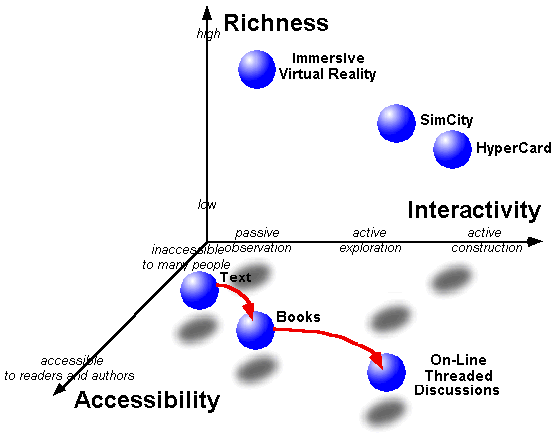Educational technologies
This article or section is currently under construction
In principle, someone is working on it and there should be a better version in a not so distant future.
If you want to modify this page, please discuss it with the person working on it (see the "history")
Definition
Educational technologies are technologies that are used in education. Not to be confounded with educational technology - the field.
See also the very complete History of virtual learning environments.
Families of technologies
DSchneider is not yet sure which categories to adopt and how to create a global taxonomy.
Overview
Basque and Lundgren-Cayrol (2003) found and analyzed 24 different typologies of ICT usage in schools. These authors suggest three kinds of typologies:
- Typologies centered on the teaching/learning act and that use classification criteria like the (1) computer's role in a pedagogical relation, (2) learner/computer control, (3) pedagogic strategy, (3) association of ICT to a specific stage in a instructional design.
- Typologies centered on the school and educational actors, i.e. (1) typologies that associate ICT with school activities and (2) those focus on ICT use by the actors
- Typologies centered on the learner, i.e. (1) typologies that categorize ICT usage according to learner preferrences for cognitive strategies, (2) those who categorize ICT according to cognitive functions they support and (3) those that classify ICT according to their support for learning stages or cognitive processing stages.
The Media Cube
Repenning et al. (1998) define media with three dimensions: media richness, interactivity and accessibility.
]]
This picture argues that different kinds of media have different kinds of affordances for the design of learning environments. See also the big media debate which is about the question whether media "can even be the message", i.e. that a medium could incomporporate a instructional functionality that can not be had with an other.
A flat typology of major categories
- This is very provisional
School and student administration
- no entries so far here
Resource management, databases, libraries
- Repositories
- Hypertext
Cognitive tools
Overview: cognitive tools
Communication and collaboration
- Overview: Computer-mediated communication
- Groupware
- Instant messaging and other forms of Chat
- Forums,
- Videoconferencing
- (some) LMS modules
ICT as a subject
- Development and programming tools
- Programming Microworlds like Logo
Microworlds, Simulation, Experimentation, Games
- Computer-based learning software.
- Microworlds
- Simulations,
- Hypertext
Professional Tools
E.g. Word processors, HTML editors, Mathematical and simulation software
Teaching tools and assessment
- Course preparation tools
- Presentation software (e.g. Powerpoint)
- Videoconferencing
Tutoring and exercising
- computer-based training software, also called courseware sometimes.
- web-based training software, e.g. the e-instruction core of e-learning
- Multimedia
Environments for project-oriented learning
(including problem-based learning, inquiry-based learning, project-based learning etc.)
- Portals such as C3MS
- Various groupware
- Collaborative hypertexts such as Wikis
- Learning environments like WISE, BGuILE, Knowledge Forum
Links
- TECHNOS Quarterly. TQ: TECHNOS Quarterly for Education and Technology is a forum for the discussion of ideas about the use of technology in education, with a focus on reform (1992 - 2002)
- European Committee for Standardization (CEN)- Learning Technologies. List of CWAs (publications)
References
- Basque, Josianne & Sylvie Doré (1998) Le concept d'environnement d'apprentissage informatisé, Journal of Distance Education/Revue de l'enseignement à distance, 13(1), ISSN 0830-0445, HTML
- Basque, J, & K. Lundgren-Cayrol, K. (2003). Une typologie des usages des TIC en éducation. Document pédagogique du cours TEC 6200 "Technologie de l'information et développement cognitif", Montréal: Télé-université. PDF
- Denis, Brigitte (2002), Quels usages des logiciels mettre en oeuvre en contexte éducatif ? Centre de Recherche sur l'Instrumentation, la Formation et l'Apprentissage (CRIFA) du Service de Technologie de l'Education de l'Université de Liège (STE-Ulg) PDF. (retrieved 18:36, 26 June 2006 (MEST)).
- Locatis,Craig, Al-Nuaim,Hana (1999), Interactive technology and authoring tools: A historical review and analysis, Educational Technology Research and Development, 47, 3, 9/18/1999, Pages 63-75, DOI 10.1007/BF02299634 (Access restricted)
- Repenning, A., Ioannidou, A. and Ambach, J. (1998). Learn to Communicate and Communicate to Learn. Journal of Interactive Media in Education, 98 (7). HTML Hypertext - HTML
- University of California at Berkeley, Field Guide to Design Experiments in Education, Chapter "Design Experiment Technologies" HTML in
- Using Technology to Support Education Reform - September 1993, Chapter II: Educational Technologies, HTML
- Marshall, J. Granville (2000), Understanding the Peril & Promise, Nouns & Verbs, of Educational Technologies, Technos: Quarterly for Education and Technology. HTML - HTML Print
- Zuckerman, O. (2006, in preparation). Historical Overview and Classification of Traditional and Digital Learning Objects, MIT Media Lab. PDF.
